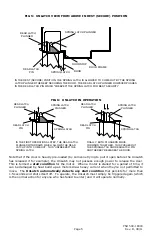
PN# 500-18300
Page 7
Rev. D, 08/11
Note: The addition of the zener diodes is only required when using the UNL-24 with 24VAC
transformer and bridge rectifier. When using the UNL-12 with 12VAC transformer and bridge
rectifier the zener diodes are not necessary.
Power supply capacity, however, is ideally 3 Amps @ 12 VDC or 1.5 Amps @ 24 VDC for best
operation. This is because the UnLatch’s motor (like all motors) will momentarily draw a lot
more current if it has to “work harder”. This occurs for a very short time at motor start. If
power supply capacity is limited, the UnLatch will still operate but it will operate a bit more
slowly. The same condition of high current draw will occur for a longer period of time if the latch
is binding which could be a permanent condition of the latch or could be because the person
trying to enter is pulling on the door. Again, the UnLatch will function but more slowly and
weakly. If a full capacity power supply is not practical, a 1 Amp power supply which includes
battery backup such as Securitron’s model BPS-12-1 or BPS-24-1 is an equally effective device
to power the UnLatch as the battery will provide the extra surge current as it is needed.
Another point to note is that when one relatively large power supply is serving a number of
UnLatches, the extra current capability will always be there as each UnLatch will operate at
different times so each can draw extra current from the power supply when needed.
If you are using a smaller capacity power source, you may well be satisfied with the
operation of the UnLatch since the reduction in torque is only really noticeable when the door is
pre-loaded. There is, however, an important electronic effect. During the brief moment (100
milliseconds) while the motor is starting to move, the UnLatch will “try” to draw 3 or 1.5 Amps
(depending on the voltage). A power supply of lower capacity will react to this condition by
sharply dropping its voltage for the same brief period. While this will not harm the power
supply, it may “crash” microprocessor equipped devices like digital keypads (such as Securitron’s
model DK-11 or DK-26) that are being operated from the same power supply. If, therefore,
your installation includes a digital keypad, or other microprocessor equipped device, make sure
you have full power supply capacity or use a separate power supply for the keypad or other
device.
4.2 WIRE GAUGE SIZING
If the power supply is some distance from the lock, voltage will be lost (dropped) in the
connecting wires so that the UnLatch will not receive full voltage. The amount of voltage that is
dropped in the wires depends on the resistance of the “round trip” wire run compared to the
resistance of the UnLatch. The issue is complicated by the fact that the resistance of the
UnLatch is 35 Ohms @ 12 VDC or 120 Ohms @ 24 VDC when it is operating (the motor is
moving) but the resistance drops as low as 4 Ohms @ 12 VDC or 16 Ohms @ 24 VDC for 100
milliseconds just as the motor starts. If the unit is denied full voltage during this motor start
period, it will operate but with less torque so it will not release the latch as crisply when the
latch has pre-load on it. Selecting thick wires to power the UnLatch will maintain strong
torque even during start up. The following table shows distances from the UnLatch to the
power source and calls out the wire gauge needed to fully maintain torque. Note that if your
installation requires the power source to be more distant or has other complications, the factory
can assist you.
Distance (one way)
50 ft. (15 M)
100 ft. (30 M)
200 ft. (60 M)
Wire Gauge for UNL-12
16
14
12
Wire Gauge for UNL-24
22
20
18
4.3 LATCH STATUS SENSING
The UnLatch includes a latch status sensing feature. When the door is
closed and the door latch has engaged the UnLatch (specifically the
spring latch plunger has been pushed in by the door latch), the UnLatch
will report this secure condition by outputting a closed circuit
condition between the white (COM) and green wires (see the drawing to
the right). When the door is not securely latched, the closure will be
between the white and blue wires. This dry SPDT output can carry 1 Amp @ 30 VDC
maximum. This signal is normally connected to the building alarm system and it provides
superior information compared to conventional door contacts which show only that the door is
closed, not whether it is latched. Note that the UnLatch’s ability to report on the latched status
NC
NO
COM
WHITE
GREEN
BLUE




























